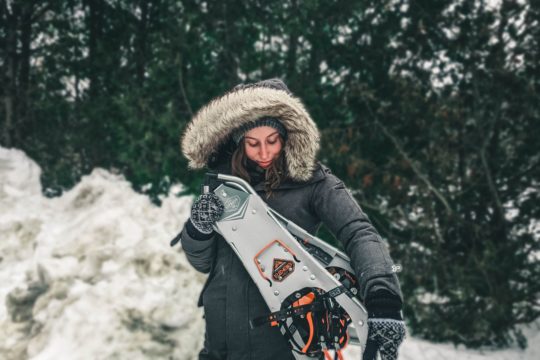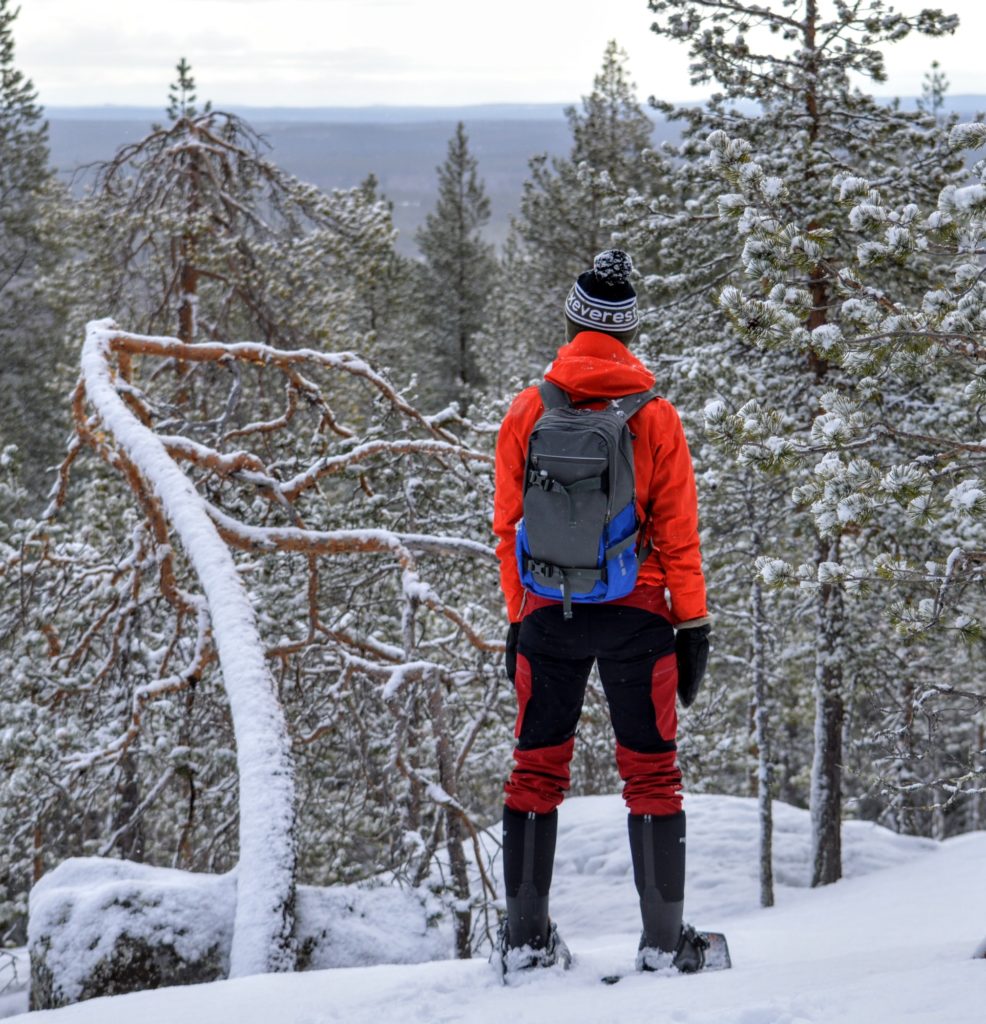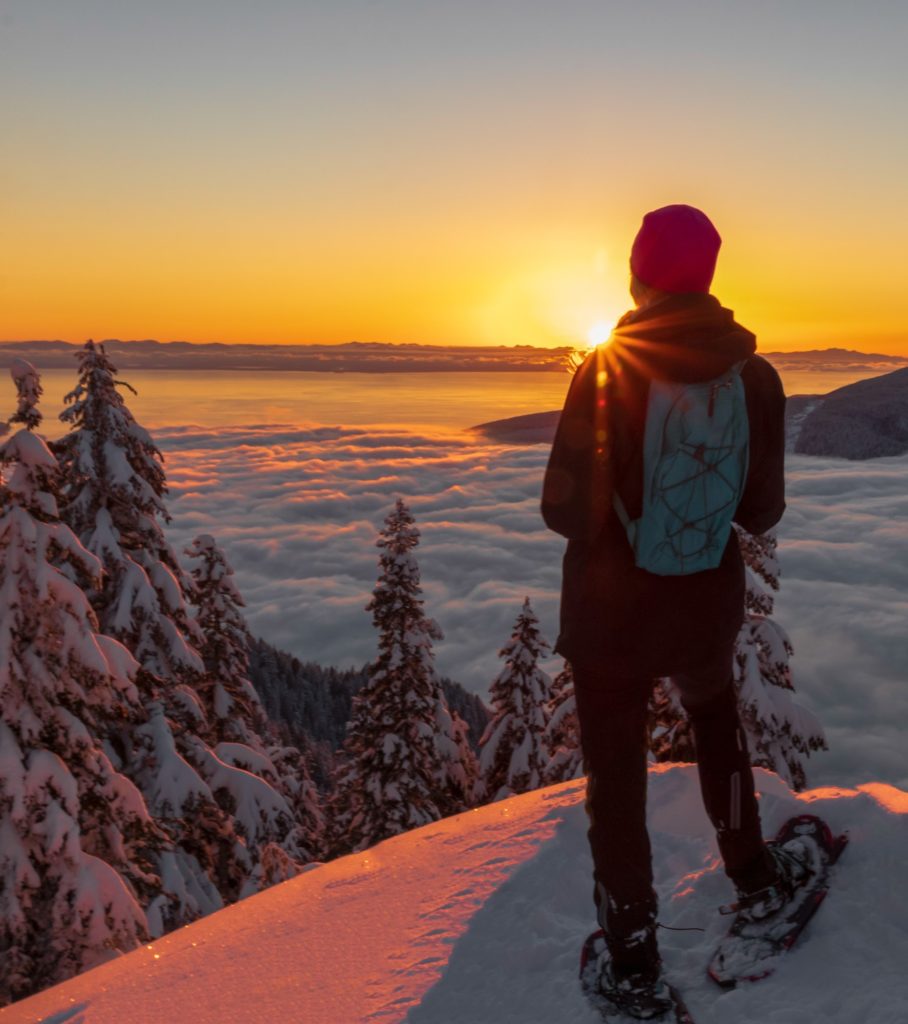By Dylan Murphy
How to Dress for Snowshoeing
Before you go out snowshoeing, you should check first if you are wearing the right clothes.
You don’t want to find yourself underdressed and feel cold when exposed to winter weather, nor do you want to be overdressed, feeling all sweaty instead because you packed too many layers and are feeling too warm as a result.
Knowing the right way to wear winter clothing, along with accessorizing well, helps you be prepared for whatever weather conditions you might face, maximizing your time and joy spent snowshoeing.
Here is a summary of how you should dress for snowshoeing:

How to Dress for Snowshoeing
- Wear multiple layers of clothes instead of only one main article of clothing. You should have three main layers: a breathable base layer, an insulating middle layer, and a weather-protective outer layer.
- Prepare the proper footwear. These include your snowshoes, snowshoeing boots, and snowshoeing socks.
- Wear gaiters to avoid getting snow and other debris from entering your boots.
- Put on a hat and a pair of gloves to protect your head and hands.
- You can use face and neck coverings such as balaclavas and neck gaiters for additional protection and warmth.
This guide will outline the essential clothing you should wear or pack when you go out snowshoeing. We also recommended different types of materials that best suit different conditions and settings, depending on your needs. Let’s get started!
What to Wear When You Go Snowshoeing
Layered Clothing
An essential concept when it comes to dressing for snowshoeing is layering. Wearing multiple layers of clothes instead of only one main article of clothing allows you to adjust to changes in temperature and the environment.
For example, when the weather gets warm, you can remove some layers and keep them in your snowshoeing backpack. And when it gets too cold, or when it starts to get windy or rainy or snowy, you can add layers instead: wearing just one oversized jacket or coat doesn’t allow you to make such adjustments.
Having multiple layers helps give you as much comfort as possible and the most suitable warmth settings. The best clothing material that would provide said comfort and warmth are either synthetic or merino wool. Both merino wool and synthetic wick moisture away efficiently, dry quickly, and even keep you warm when they get wet.
Synthetic is a durable material that quickly wicks moisture, dries fast, and is relatively cheaper than merino wool. A downside to it, though, is that it can get a bit smelly when damp.
Merino wool is better at wicking away sweat, as it transports moisture while it is still in vapor form, so you don’t have to worry about feeling clammy. Merino wool also offers more warmth than synthetic, regulates body temperature, cancels odors, and is very soft.
A downside to merino wool is that it can be a problem for those allergic to wool. Merino wool is also relatively more expensive than synthetic.
On the other hand, material such as cotton absorbs moisture, dries slowly, and keeps you cold when wet, so it is best to avoid this type of material for snowshoeing clothing.
There are three main layers to consider when layering – the base layer, mid-layer, and outer layer.
Let’s have a look at them in more detail:
Base layer
The base or inner layer is the layer that has direct contact with your skin. The primary function of the base layer is to wick away moisture or sweat from your skin, so you stay dry and warm.
Like any other outdoor activity, snowshoeing can make you sweat, and when snowshoeing in cold conditions, your sweat can get your clothes wet and potentially result in you feeling cold. Therefore, the material your base layer is made of must have the ability to wick away sweat and dry quickly. As such, synthetic and merino wool are the most common types of material used for base layers.
For the top, you can go with a long-sleeved, crew neck type or a quarter-zip so you can vent on warmer days. You can wear long johns or winter tights for the bottom part and synthetic briefs and bras for other underwear.
Middle layer
The middle or second layer is worn over the base layer. The primary function of the middle layer is to provide you insulation and keep you warm.
Middle layers trap air to keep you warm, and the more air that is trapped, the more insulation you are provided. It is also essential that the mid-layer comprises a material that allows the sweat wicked by the base layer to continue traveling away from your body. The most common materials used for the middle layer are fleece, synthetic, and wool.
You can go with a fleece or puffy jacket for the top; you can wear a fleece layer under a puffy one to increase the warmth provided. You can also opt to wear a vest instead, as it offers you more mobility around the arms when you go snowshoeing.
The middle layer for the bottom part is usually skipped because it can be too warm, but you can go with fleece pants in colder weather conditions.
Outer layer
The outer or third layer is worn over the middle layer and has the primary function of protecting you from the elements, such as wind, rain, and snow.
Your outer clothing should be durable, waterproof, windproof, and highly breathable. Outer layers typically come in the form of hardshell jackets. Hardshell jackets are excellent when it comes to keeping out the elements and can even withstand harsh weather conditions for long periods when you are on an extended snowshoeing trip.
The jackets in the Arc’teryx series provide you with plenty of great options to choose from, as they are made with highly durable Gore-Tex material specifically made for such conditions. Some of the jackets in the series even come with ventilation options such as pit zips for letting heat out when the weather gets warmer.
There are also outer layers that are insulated, such as down jackets, providing you extra warmth in addition to the insulation provided by your middle layer. A downside to these types of usually, though, is that they are cold when wet, so you should first research what weather conditions you’ll be facing when you go out snowshoeing before choosing such outer-layer types.
You can also go with hardshell pants for the bottom part or more simple waterproof pants if you want more breathability.
Footwear
Snowshoes
Of course, you can’t enjoy snowshoeing to the fullest without snowshoes. Having an excellent pair of snowshoes allows you to move around in the snow much more efficiently as you can venture even into areas with deeper snow. Snowshoes also help keep you from slipping on icy terrain and provide excellent traction while providing your feet comfort.
The best types of snowshoes are those that are: made of durable material such as nylon decking, offer excellent traction features such as toe and heel crampons, have a binding system that is easy to use like single-pull strap (SPL) systems, have the proper length to fit your feet, and give comfort to your feet such as those incorporating soft EVA padding.
Snowshoeing Boots
As essential as snowshoes are for snowshoeing, equally important is having an excellent pair of snowshoeing boots. While snowshoes help you move around in the snow better, snowshoeing boots protect your feet from the elements – be they wind, rain, or snow – and keep them warm and dry.
The best types of snowshoeing boots are those that provide excellent insulation, so your feet stay warm, incorporate waterproof material to protect from moisture, offer superb comfort, and are relatively lightweight.
Snowshoeing Socks
An excellent pair of socks are a must-have when it comes to keeping your feet and toes warm. Because your feet are almost always in contact with the snow when you go snowshoeing, your winter boots may not be enough in providing enough insulation to keep them warm, especially in deeper snow.
Having the right socks not only gives you that extra warmth but also helps wick away sweat, provides cushioning, and makes wearing your snowshoeing boots more comfortable.
The most common materials used for snowshoeing socks are either merino wool or synthetic. And while both materials provide you that extra-needed warmth, heated socks go the next level in providing warmth to your feet. Heated socks have an integrated heating system that quickly heats the sock and comes with a battery so the sock can stay constantly and reliably heated for hours, allowing you to go snowshoeing for much more extended periods. The only major downside to heated socks is that they are relatively more expensive than merino or synthetic socks.
Gaiters
When you go snowshoeing, snow or rain can enter your snow boots, resulting in your feet getting wet and cold. Gaiters help you avoid this predicament, as their primary function is to keep snow and any other debris from entering your boots, which can be especially helpful when snowshoeing in deeper snow. Gaiters also protect your legs from rough terrain features such as bushes and rocks.
The best types of gaiters are those comprised of excellent waterproofing material such as Gore-Tex, are tall enough to keep snow out of your boots, made of durable material that is highly resistant to abrasion, easy to wear, and are relatively lightweight.
Hats
The top of your head can also get cold or sweaty depending on the weather, so having a hat can help give you added protection from the elements.
Winter hats made of wool or synthetic material are excellent options to choose from, as they both provide excellent insulation and can wick away moisture quickly. Windproof and waterproof hats are also great possible alternatives. You can go with wide brim hats or a baseball cap for fairer weather conditions, as they protect your eyes from the sun and don’t feel too warm.
Gloves
Protecting your hands or your extremities is just as important as covering yourself with the three main layers previously mentioned. You don’t want to find your fingers getting frostbitten because your hands did not have enough protective layering.
Gloves or mittens are essential to have when you go snowshoeing, especially in freezing conditions. Like with snow hats, the best materials are also wool or synthetic; waterproof and insulated ones are also viable options.
Gloves may be preferable to mittens because they provide more dexterity and allow you to handle your snowshoeing equipment better without having to take them off.
You can wear glove liners underneath your mittens or gloves for added insulation. You can wear lighter fleece gloves or just your glove liners instead so your hands don’t feel too warm for sunnier weather.
Other Accessories
Face covers
If you want additional protection for your face, then balaclavas or ski masks are a great option. Balaclavas cover most of your face and even include your head and neck. For protecting your eyes from either sun or snow, you can go with polarized or regular sunglasses.
Neck covers
For covering the neck area, neck gaiters or buffs are great options, as they not only keep you warm but also protect you from the wind or the sun’s rays on warmer days.
FAQs
What should I wear for my first time snowshoeing?
The essential attire for those snowshoeing for the first time should have the following:
- Layered clothing – these include a base layer, middle layer, and an outer layer
- Snowshoes
- Snowshoeing boots
- Snowshoeing socks
- Gaiters
What kind of socks do you wear for snowshoeing?
You can go with either merino wool or synthetic when choosing the material of your snowshoeing socks. If you are looking for socks that provide much more warmth and don’t mind spending a bit more money, then you might want to look into heated socks.
Do you need to wear a thin hat when snowshoeing?
Having a hat can give your head protection from the elements while providing warmth. Thin hats or ball caps are more suitable for warmer weather, as they don’t feel too hot and still protect you from the sun.
What kind of clothes should I wear for winter hiking?
For winter hiking or snowshoeing, wear multiple layers of clothes instead of just one article of clothing.
Choose a base layer that is breathable and wicks away sweat quickly, such as those made of merino wool or synthetic material.
Choose a material that provides enough insulation and warmth for your middle layers, such as synthetic, fleece, or wool.
Finally, your outer layer should protect you from the elements. Choose material such as Gore-Tex that is waterproof, windproof, has high resistance to abrasions and tearing, and is highly breathable.
Conclusion
There are a few factors to consider when preparing what to wear for snowshoeing, such as weather conditions, temperature, clothing material, and necessity.
What is important is that your clothes provide proper protection and make you feel comfortable as well.

